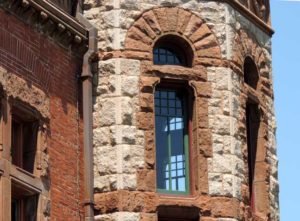
(Note: photos used in this article are from the Buffalo Architecture and History website. In 1869, Henry Hobson Richardson designed the largest building of his career, a New York state hospital, located in Buffalo, with grounds designed by Frederick Law Olmsted. Now called the Richardson Olmsted Complex, the property was the debut of Richardsonian Romanesque. In its presentation of the Richardson Olmsted Complex, and explanation of the H.H. Richardson style, Buffalo Architecture and History employed photos of Oakes Ames Memorial Hall.)
Oakes Ames Memorial Hall is among the most magnificent – actually, we are confident in calling it awe-inspiring – properties in America.
It is also one of the grandest and most popular special event spaces in Metropolitan Boston.

Magnificent, awe-inspiring, and grand … yes, it is all that … with the building designed by Henry Hobson Richardson, who, along with Louis Sullivan and Frank Lloyd Wright constitute the Trinity of American Architecture – and the land on which the building sits designed by Frederick Law Olmsted, the Father of American Landscape Architecture.
Oakes Ames Memorial Hall is the setting for the happiest and most memorable occasions and entertainment events: wedding receptions, birthday parties, class reunions, anniversary parties, family reunions, awards dinners, fundraisers, music performances … and more.
On June 28th, here, was a post which featured a discussion of the architectural style of Henry Hobson Richardson – style beautifully manifest in Oakes Ames Memorial Hall.
Style that is called Richardsonian Romanesque.
Oakes Ames Memorial Hall is an edifice ingeniously crafted of stone and brick.
Woven into, adorning, and ribbing the building are buttresses, arches, moldings, and finials composed of a reddish brown stone.
What is that reddish brown stone? Besides, you know, reddish brown stone?
Well, more specifically, it is a reddish brown sandstone – a stone that is abundant in H. H. Richardson buildings.
The reddish brown sandstone in Oakes Ames Memorial Hall was quarried in Massachusetts, in the town of East Longmeadow, a community in the central part of the state, which shares a border with Connecticut.
East Longmeadow, settled in 1720, and incorporated in 1894, had a thriving quarry industry from the latter part of the mid-19th Century up until the mid-20th Century.
Longmeadow sandstone – which varied in color from brown to blood red – mined and cut from the East Longmeadow earth, was highly valued and widely used as a building material, until the invention of the less expensive but equally durable construction systems of steel framing and concrete.
Working the quarries were immigrants, with the largest percentage from Italy, a reason that East Longmeadow today has a large Italian population.
If you click here you will be taken to an interesting MassLive story, by Staasi Heropoulos, which features history of the East Longmeadow quarries, and was published on October 10, 2010.
In a future post here we will discuss background and history on other materials from which Oakes Ames Memorial Hall is constructed